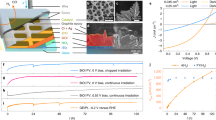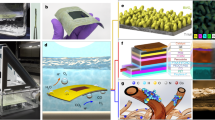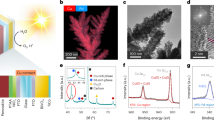Abstract
The photoelectrochemical (PEC) production of syngas from water and CO2 represents an attractive technology towards a circular carbon economy. However, the high overpotential, low selectivity and cost of commonly employed catalysts pose challenges for this sustainable energy-conversion process. Here we demonstrate highly tunable PEC syngas production by integrating a cobalt porphyrin catalyst immobilized on carbon nanotubes with triple-cation mixed halide perovskite and BiVO4 photoabsorbers. Empirical data analysis is used to clarify the optimal electrode selectivity at low catalyst loadings. The perovskite photocathodes maintain selective aqueous CO2 reduction for one day at light intensities as low as 0.1 sun, which provides pathways to maximize daylight utilization by operating even under low solar irradiance. Under 1 sun irradiation, the perovskite–BiVO4 PEC tandems sustain bias-free syngas production coupled to water oxidation for three days. The devices present solar-to-H2 and solar-to-CO conversion efficiencies of 0.06 and 0.02%, respectively, and are able to operate as standalone artificial leaves in neutral pH solution.
This is a preview of subscription content, access via your institution
Access options
Access Nature and 54 other Nature Portfolio journals
Get Nature+, our best-value online-access subscription
$29.99 / 30 days
cancel any time
Subscribe to this journal
Receive 12 print issues and online access
$259.00 per year
only $21.58 per issue
Buy this article
- Purchase on Springer Link
- Instant access to full article PDF
Prices may be subject to local taxes which are calculated during checkout




Similar content being viewed by others
Data availability
The raw data that support the findings of this study are available from the University of Cambridge data repository53: https://doi.org/10.17863/CAM.44164.
References
Behrens, M. et al. The active site of methanol synthesis over Cu/ZnO/Al2O3 industrial catalysts. Science 336, 893–897 (2012).
Khodakov, A. Y., Chu, W. & Fongarland, P. Advances in the development of novel cobalt Fischer–Tropsch catalysts for synthesis of long-chain hydrocarbons and clean fuels. Chem. Rev. 107, 1692–1744 (2007).
Bharadwaj, S. S. & Schmidt, L. D. Catalytic partial oxidation of natural gas to syngas. Fuel Process. Technol. 42, 109–127 (1995).
Abdoulmoumine, N., Adhikari, S., Kulkarni, A. & Chattanathan, S. A review on biomass gasification syngas cleanup. Appl. Energy 155, 294–307 (2015).
Graves, C., Ebbesen, S. D., Mogensen, M. & Lackner, K. S. Sustainable hydrocarbon fuels by recycling CO2 and H2O with renewable or nuclear energy. Renew. Sustain. Energy Rev. 15, 1–23 (2011).
Shaner, M. R. et al. Photoelectrochemistry of core–shell tandem junction n–p+-Si/n-WO3 microwire array photoelectrodes. Energy Environ. Sci. 7, 779–790 (2014).
Brillet, J. et al. Highly efficient water splitting by a dual-absorber tandem cell. Nat. Photon. 6, 824 (2012).
Pan, L. et al. Boosting the performance of Cu2O photocathodes for unassisted solar water splitting devices. Nat. Catal. 1, 412–420 (2018).
Wang, Q. et al. Scalable water splitting on particulate photocatalyst sheets with a solar-to-hydrogen energy conversion efficiency exceeding 1%. Nat. Mater. 15, 611 (2016).
Lu, H. et al. Single-source bismuth (transition metal) polyoxovanadate precursors for the scalable synthesis of doped BiVO4 photoanodes. Adv. Mater. 30, 1804033 (2018).
Luo, J. et al. Water photolysis at 12.3% efficiency via perovskite photovoltaics and earth-abundant catalysts. Science 345, 1593–1596 (2014).
Andrei, V. et al. Scalable triple cation mixed halide perovskite–BiVO4 tandems for bias-free water splitting. Adv. Energy Mater. 8, 1801403 (2018).
Schreier, M. et al. Efficient photosynthesis of carbon monoxide from CO2 using perovskite photovoltaics. Nat. Commun. 6, 7326 (2015).
Jang, Y. J. et al. Unbiased sunlight-driven artificial photosynthesis of carbon monoxide from CO2 using a ZnTe-based photocathode and a perovskite solar cell in tandem. ACS Nano 10, 6980–6987 (2016).
Sokol, K. P. et al. Photoreduction of CO2 with a formate dehydrogenase driven by photosystem II using a semi-artificial Z-scheme architecture. J. Am. Chem. Soc. 140, 16418–16422 (2018).
Li, C. et al. Photoelectrochemical CO2 reduction to adjustable syngas on grain-boundary-mediated a-Si/TiO2/Au photocathodes with low onset potentials. Energy Environ. Sci. 12, 923–928 (2019).
Sahara, G. et al. Photoelectrochemical reduction of CO2 coupled to water oxidation using a photocathode with a Ru(ii)–Re(i) complex photocatalyst and a CoOx/TaON photoanode. J. Am. Chem. Soc. 138, 14152–14158 (2016).
Urbain, F. et al. A prototype reactor for highly selective solar-driven CO2 reduction to synthesis gas using nanosized earth-abundant catalysts and silicon photovoltaics. Energy Environ. Sci. 10, 2256–2266 (2017).
Arai, T., Sato, S., Sekizawa, K., Suzuki, T. M. & Morikawa, T. Solar-driven CO2 to CO reduction utilizing H2O as an electron donor by earth-abundant Mn–bipyridine complex and Ni-modified Fe-oxyhydroxide catalysts activated in a single-compartment reactor. Chem. Commun. 55, 237–240 (2019).
Voiry, D., Shin, H. S., Loh, K. P. & Chhowalla, M. Low-dimensional catalysts for hydrogen evolution and CO2 reduction. Nat. Rev. Chem. 2, 0105 (2018).
Francke, R., Schille, B. & Roemelt, M. Homogeneously catalyzed electroreduction of carbon dioxide—methods, mechanisms, and catalysts. Chem. Rev. 118, 4631–4701 (2018).
Dalle, K. E. et al. Electro- and solar-driven fuel synthesis with first row transition metal complexes. Chem. Rev. 119, 2752–2875 (2019).
Costentin, C., Drouet, S., Robert, M. & Savéant, J.-M. A local proton source enhances CO2 electroreduction to CO by a molecular Fe catalyst. Science 338, 90–94 (2012).
Lin, S. et al. Covalent organic frameworks comprising cobalt porphyrins for catalytic CO2 reduction in water. Science 349, 1208–1213 (2015).
Zhu, M., Ye, R., Jin, K., Lazouski, N. & Manthiram, K. Elucidating the reactivity and mechanism of CO2 electroreduction at highly dispersed cobalt phthalocyanine. ACS Energy Lett. 3, 1381–1386 (2018).
Hu, X.-M., Rønne, M. H., Pedersen, S. U., Skrydstrup, T. & Daasbjerg, K. Enhanced catalytic activity of cobalt porphyrin in CO2 electroreduction upon immobilization on carbon materials. Angew. Chem. Int. Ed. 56, 6468–6472 (2017).
Zhang, X. et al. Highly selective and active CO2 reduction electrocatalysts based on cobalt phthalocyanine/carbon nanotube hybrid structures. Nat. Commun. 8, 14675 (2017).
Li, C. W., Ciston, J. & Kanan, M. W. Electroreduction of carbon monoxide to liquid fuel on oxide-derived nanocrystalline copper. Nature 508, 504–507 (2014).
Hall, A. S., Yoon, Y., Wuttig, A. & Surendranath, Y. Mesostructure-induced selectivity in CO2 reduction catalysis. J. Am. Chem. Soc. 137, 14834–14837 (2015).
Ma, M., Trześniewski, B. J., Xie, J. & Smith, W. A. Selective and efficient reduction of carbon dioxide to carbon monoxide on oxide-derived nanostructured silver electrocatalysts. Angew. Chem. Int. Ed. 55, 9748–9752 (2016).
de Luna, P. et al. Catalyst electro-redeposition controls morphology and oxidation state for selective carbon dioxide reduction. Nat. Catal. 1, 103–110 (2018).
Suter, S. & Haussener, S. Optimizing mesostructured silver catalysts for selective carbon dioxide conversion into fuels. Energy Environ. Sci. 12, 1668–1678 (2019).
Sharma, A. & Kakkar, A. Forecasting daily global solar irradiance generation using machine learning. Renew. Sustain. Energy Rev. 82, 2254–2269 (2018).
Stoffel, T. & Andreas, A. NREL Solar Radiation Research Laboratory (SRRL): Baseline Measurement System (BMS); Golden, Colorado (Data) NREL Report no. DA-5500-56488(NREL, 1981).
Hernández-Pagán, E. A. et al. Resistance and polarization losses in aqueous buffer–membrane electrolytes for water-splitting photoelectrochemical cells. Energy Environ. Sci. 5, 7582–7589 (2012).
Vermaas, D. A. & Smith, W. A. Synergistic electrochemical CO2 reduction and water oxidation with a bipolar membrane. ACS Energy Lett. 1, 1143–1148 (2016).
Singh, M. R., Xiang, C. & Lewis, N. S. Evaluation of flow schemes for near-neutral pH electrolytes in solar-fuel generators. Sustain. Energy Fuels 1, 458–466 (2017).
McKone, J. R., Lewis, N. S. & Gray, H. B. Will solar-driven water-splitting devices see the light of day? Chem. Mater. 26, 407–414 (2014).
Lee, Y. W. et al. Unbiased biocatalytic solar-to-chemical conversion by FeOOH/BiVO4/perovskite tandem structure. Nat. Commun. 9, 4208 (2018).
Zhang, H. et al. A sandwich-like organolead halide perovskite photocathode for efficient and durable photoelectrochemical hydrogen evolution in water. Adv. Energy Mater. 8, 1800795 (2018).
Joya, K. S., Joya, Y. F., Ocakoglu, K. & van de Krol, R. Water-splitting catalysis and solar fuel devices: artificial leaves on the move. Angew. Chem. Int. Ed. 52, 10426–10437 (2013).
Hu, S., Xiang, C., Haussener, S., Berger, A. D. & Lewis, N. S. An analysis of the optimal band gaps of light absorbers in integrated tandem photoelectrochemical water-splitting systems. Energy Environ. Sci. 6, 2984–2993 (2013).
Wang, Q., Dong, Q., Li, T., Gruverman, A. & Huang, J. Thin insulating tunneling contacts for efficient and water-resistant perovskite solar cells. Adv. Mater. 28, 6734–6739 (2016).
Qiu, Y. et al. Efficient solar-driven water splitting by nanocone BiVO4–perovskite tandem cells. Sci. Adv. 2, e1501764 (2016).
Azcarate, I., Costentin, C., Robert, M. & Savéant, J.-M. Through-space charge interaction substituent effects in molecular catalysis leading to the design of the most efficient catalyst of CO2-to-CO electrochemical conversion. J. Am. Chem. Soc. 138, 16639–16644 (2016).
Sato, S., Saita, K., Sekizawa, K., Maeda, S. & Morikawa, T. Low-energy electrocatalytic CO2 reduction in water over Mn–complex catalyst electrode aided by a nanocarbon support and K+ cations. ACS Catal. 8, 4452–4458 (2018).
Zhou, X. et al. Solar-driven reduction of 1 atm of CO2 to formate at 10% energy-conversion efficiency by use of a TiO2-protected III–V tandem photoanode in conjunction with a bipolar membrane and a Pd/C cathode. ACS Energy Lett. 1, 764–770 (2016).
Reece, S. Y. et al. Wireless solar water splitting using silicon-based semiconductors and earth-abundant catalysts. Science 334, 645–648 (2011).
Rao, H., Schmidt, L. C., Bonin, J. & Robert, M. Visible-light-driven methane formation from CO2 with a molecular iron catalyst. Nature 548, 74 (2017).
Reuillard, B., Warnan, J., Leung, J. J., Wakerley, D. W. & Reisner, E. A poly(cobaloxime)/carbon nanotube electrode: freestanding buckypaper with polymer-enhanced H2-evolution performance. Angew. Chem. Int. Ed. 55, 3952–3957 (2016).
Hoye, R. L. Z. et al. Strongly enhanced photovoltaic performance and defect physics of air-stable bismuth oxyiodide (BiOI). Adv. Mater. 29, 1702176 (2017).
Harris, D. C. Quantitative Chemical Analysis 7th edn. (W.H. Freeman and Co., New York, NY, 2007).
Andrei, V., Reuillard, B. & Reisner, E. Raw Data Supporting Article: Bias-free Solar Syngas Production by Integrating a Molecular Cobalt Catalyst with Perovskite–BiVO 4 Tandems (2019); https://doi.org/10.17863/CAM.44164
Acknowledgements
This work was supported by the Christian Doppler Research Association (Austrian Federal Ministry for Digital and Economic Affairs and the National Foundation for Research, Technology and Development) and the OMV Group (E.R.). V.A. is grateful for the financial support from the Cambridge Trusts (Vice-Chancellor’s Award) and the Winton Programme for the Physics of Sustainability. B.R. was supported by the BBSRC (grant no. BB/K010220/1). XPS data collection was performed at the EPSRC National Facility for Photoelectron spectroscopy (‘HarwellXPS’), operated by Cardiff University and UCL under contract no. PR16195. We acknowledge D. S. Wright (University of Cambridge) for providing us the Co WOC precursor. We thank A. Dickerson (University of Cambridge) for the ICP-OES measurements. We are grateful to D. Achilleos (University of Cambridge) for help with XPS sample preparation and data analysis. We thank K. P. Sokol (University of Cambridge) for helpful advice on the O2 measurements, and K. P. Sokol and A. Wagner (University of Cambridge) for useful feedback on the manuscript.
Author information
Authors and Affiliations
Contributions
V.A., B.R. and E.R. designed the project. V.A. prepared the photoelectrodes, performed the experiments and drafted the manuscript. V.A., B.R. and E.R. analysed the data. B.R. and E.R. contributed to the discussion and completion of the manuscript. E.R. supervised the work.
Corresponding author
Ethics declarations
Competing interests
The authors declare no competing interests.
Additional information
Publisher’s note Springer Nature remains neutral with regard to jurisdictional claims in published maps and institutional affiliations.
Supplementary information
Supplementary Information
Supplementary Information
Supplementary Information
Supplementary Video
Rights and permissions
About this article
Cite this article
Andrei, V., Reuillard, B. & Reisner, E. Bias-free solar syngas production by integrating a molecular cobalt catalyst with perovskite–BiVO4 tandems. Nat. Mater. 19, 189–194 (2020). https://doi.org/10.1038/s41563-019-0501-6
Received:
Accepted:
Published:
Issue Date:
DOI: https://doi.org/10.1038/s41563-019-0501-6
This article is cited by
-
Liquid metal-embraced photoactive films for artificial photosynthesis
Nature Communications (2024)
-
A triple tandem reaction for the upcycling of products from poorly selective CO2 photoreduction systems
Nature Synthesis (2024)
-
Solar reforming as an emerging technology for circular chemical industries
Nature Reviews Chemistry (2024)
-
Syngas production by photoreforming of formic acid with 2D VxW1−xN1.5 solid solution as an efficient cocatalyst
Frontiers in Energy (2024)
-
Solar-driven liquid multi-carbon fuel production using a standalone perovskite–BiVO4 artificial leaf
Nature Energy (2023)



